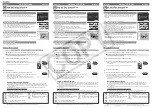
Process Execution
Chapter
6
Managing Process Execution
169
Session assignment takes place in any of the following situations:
•
An offered activity is placed in a READY state for the first time.
•
An offered activity is rolled back from an ACTIVE state to a READY state—can
occur if a client application rolls the activity back to READY state (discards any
work performed on the activity), if a system manager rolls the activity back to
READY state in order to force it to be reassigned, or if the activity is being
performed by a session that is suspended and the client has set the
suspendAction property to REMOVE (that is, remove the activity from the
session’s activity list if the session is suspended).
•
A new session is opened (or reverts from SUSPENDED to ACTIVE)—the
engine examines the list of READY Offered activities and assigns them to the
newly active session based on each activity’s assignment rules.
Transition to ACTIVE State
The engine places an Offered, READY activity in an
ACTIVE state when a client application accepts the corresponding work item. The
engine removes the activity from all sessions to which it is assigned except the one
which accepts the corresponding work item.
The engine provides the client application with the associated application
dictionary item (a reference to the application or service needed to perform the
activity, a description of the work to be performed, and any required process
attribute data). The engine ensures that any required process attributes are locked
so that no other session can access them during performance of the activity.
ACTIVE State Handling
The engine performs any work specified in the
OnActive method (if one exists in the process definition).
The client application that accepted the activity is responsible for completing the
work associated with the activity. When the client determines that the work is
complete, it informs the engine, which removes the activity from the session’s
activity list and places the activity in a COMPLETED state.
The client can abort work by requesting that the engine place the activity in an
ABORTED state, or the client can also reset the activity to READY state (discarding
any work performed on the activity, including changes in attribute values).
Queued Activities
Transition to READY State
When the trigger conditions are met, the engine
performs any work specified in the Ready method (if one exists in the process
definition) and places the activity in READY state.
Содержание iPlanet Integration Server 3.0
Страница 1: ...Process System Guide iPlanet Integration Server Version3 0 August 2001...
Страница 14: ...14 iPlanet Integration Server Process System Guide August 2001...
Страница 18: ...18 iPlanet Integration Server Process System Guide August 2001...
Страница 42: ...iIS Process Management Tools 42 iPlanet Integration Server Process System Guide August 2001...
Страница 82: ...iIS Console Main Window Command Summary 82 iPlanet Integration Server Process System Guide August 2001...
Страница 156: ...Performing Application Upgrades 156 iPlanet Integration Server Process System Guide August 2001...
Страница 226: ...Performance Charts 226 iPlanet Integration Server Process System Guide August 2001...
Страница 326: ...Conductor Script Commands 326 iPlanet Integration Server Process System Guide August 2001...
Страница 358: ...Database Schema Reference 358 iPlanet Integration Server Process System Guide August 2001...
















































